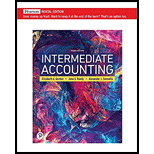
a.
Concept Introduction:
Amortization: Amortization refers to the method of accounting which lower down the book amount or book value of any loan or any intangible asset over the time period.
Bond: Bond refers to a debt instrument or a debt security which has longer period for maturity with some component of interest or return to be received on the amount paid on bond.
To prepare: The amortization table for the bond issue assuming that the company uses the effective interest rate method of amortization.
b.
Concept Introduction:
Journalizing: In accounts, for keeping records of all the business transactions properly, journalizing is being done for the transactions. Thus, it helps to track the transactions in chronological order as well as to maintain the records too.
To prepare: The journal for recording issuing bond.
c.
Concept Introduction:
Journalizing: In accounts, for keeping records of all the business transactions properly, journalizing is being done for the transactions. Thus, it helps to track the transactions in chronological order as well as to maintain the records too.
To prepare: The journal for recording first interest payment.
d.
Concept Introduction:
Journalizing:
In accounts, for keeping records of all the business transactions properly, journalizing is being done for the transactions. Thus, it helps to track the transactions in chronological order as well as to maintain the records too.
To prepare: The journal for recording conversion of bond.
Want to see the full answer?
Check out a sample textbook solution
Chapter 14 Solutions
Pearson eText Intermediate Accounting -- Instant Access (Pearson+)
- Please provide the correct answer to this general accounting problem using accurate calculations.arrow_forwardPlease explain the solution to this general accounting problem using the correct accounting principles.arrow_forwardI am searching for the accurate solution to this general accounting problem with the right approach.arrow_forward
- Zodiac Systems projected current year sales of 50,000 units at a unit sale price of $30.00. Actual current year sales were 54,000 units at $31.00 per unit. Actual variable costs, budgeted at $20.00 per unit, totaled $19.00 per unit. Budgeted fixed costs totaled $450,000, while actual fixed costs amounted to $475,000. What is the sales volume variance for total revenue?arrow_forwardI am searching for the correct answer to this general accounting problem with proper accounting rules.arrow_forwardAnswer thisarrow_forward
- Can you solve this general accounting problem with appropriate steps and explanations?arrow_forwardPlease provide the solution to this general accounting question with accurate financial calculations.arrow_forwardI need help solving this general accounting question with the proper methodology.arrow_forward

 AccountingAccountingISBN:9781337272094Author:WARREN, Carl S., Reeve, James M., Duchac, Jonathan E.Publisher:Cengage Learning,
AccountingAccountingISBN:9781337272094Author:WARREN, Carl S., Reeve, James M., Duchac, Jonathan E.Publisher:Cengage Learning, Accounting Information SystemsAccountingISBN:9781337619202Author:Hall, James A.Publisher:Cengage Learning,
Accounting Information SystemsAccountingISBN:9781337619202Author:Hall, James A.Publisher:Cengage Learning, Horngren's Cost Accounting: A Managerial Emphasis...AccountingISBN:9780134475585Author:Srikant M. Datar, Madhav V. RajanPublisher:PEARSON
Horngren's Cost Accounting: A Managerial Emphasis...AccountingISBN:9780134475585Author:Srikant M. Datar, Madhav V. RajanPublisher:PEARSON Intermediate AccountingAccountingISBN:9781259722660Author:J. David Spiceland, Mark W. Nelson, Wayne M ThomasPublisher:McGraw-Hill Education
Intermediate AccountingAccountingISBN:9781259722660Author:J. David Spiceland, Mark W. Nelson, Wayne M ThomasPublisher:McGraw-Hill Education Financial and Managerial AccountingAccountingISBN:9781259726705Author:John J Wild, Ken W. Shaw, Barbara Chiappetta Fundamental Accounting PrinciplesPublisher:McGraw-Hill Education
Financial and Managerial AccountingAccountingISBN:9781259726705Author:John J Wild, Ken W. Shaw, Barbara Chiappetta Fundamental Accounting PrinciplesPublisher:McGraw-Hill Education





